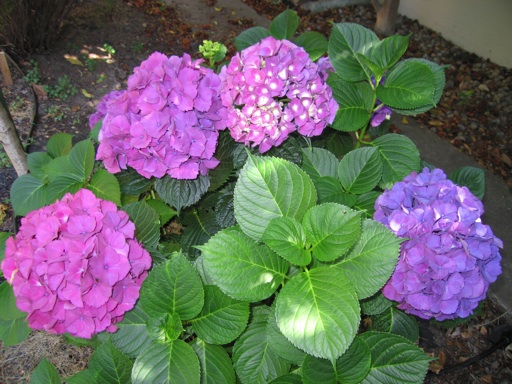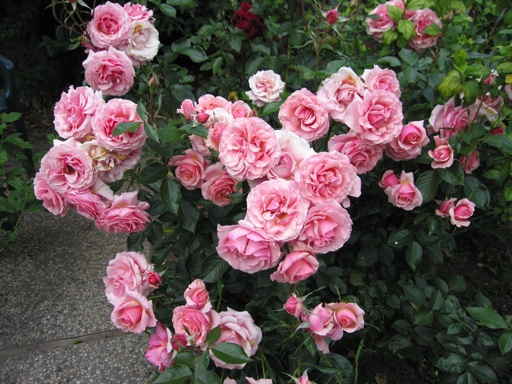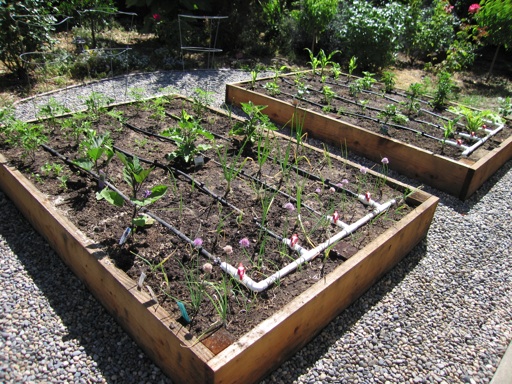The gladiolas I’ve planted in the ground in past years have been hit or miss. This year, I bought a few small purple gladiola bulbs from a nursery and planted them in one of our raised beds, which is amended with compost and gets watered every other day. They seem to love it there. The flowers look perfect today when I took this picture. Gladiola flowers are beautiful when they are in bloom, but unfortunately, each plant only blooms for about a week.

We have 7 hydrangea plants, but the hydrangea shown in this picture is growing better than the others and has the most flowers. It’s growing under our yellow peach tree and only gets a little filtered sun for a few hours a day in that spot. One of our older hydrangeas is getting sun all day. That plant often looks wilted and the leaves tend to get sunburned. We have added aluminum sulfate around the roots of the hydrangea in this picture for the past few years. Aluminum sulfate is supposed to turn hydrangea flowers blue. Its flowers used to be light pink and now they are more purple, but they are still no where near being blue.

The white star jasmine that is growing up one of our backyard fences is in bloom now. Its flowers have a wonderful summertime fragrance. We often open the bedroom windows next to the jasmine to let the fragrance come into the house.

This picture shows one of our pink roses. It was at its peak bloom about a month ago when this picture was taken. I love this particular rose, because its flowers last so long. The flowers just started to fade a few weeks ago. Many roses open and drop their petals in about a week or less. But these flowers hold their petals for weeks without dropping them. In fact, the flower petals stay on for so long that they start to turn brown on the plant before they fall off. I don’t know what variety of rose it is, because it was planted by the previous owners and there’s no tag on it.

June 26 2010 | Gladiolas and Hydrangeas and Jasmine and Roses | Comments Off on Flower Gallery 2010

We have owned the two orchid plants in this picture for about 2-3 years now, and we have managed to get them to re-bloom again and again. Our current method involves filling a large plastic tub with about 7-8 inches of water, and then adding bloom and growth orchid fertilizers to it (1 TSP each). We soak all of our orchids in the bath for about 15-30 minutes every two weeks. We no longer water them in the kitchen sink because we have 4 orchids now, and they don’t fit in the sink.
They seem to love this watering and fertilizing technique. As soon as we cut back the old flower stems, they start growing new ones. The 2 larger plants never seem to be without flower stems. The purple orchid in this picture has two flower stems, and the white orchid in this picture has several smaller flower stems branching off of one larger stem.
Although one of our smaller orchids has not bloomed in about a year. I suspect that’s because it’s growing in moss which seems to be perpetually moist. Our larger orchids are growing in bark, which dries out much faster. We probably need to transplant this orchid into a larger pot with bark.
June 20 2010 | Orchids | Comments Off on Orchids Are Back Again
In March, we added two more raised beds in our backyard. We now have four raised beds that we are growing vegetables in. This year, we are growing tomatoes, potatoes, pole beans, peppers, eggplants, onions, basil, strawberries, cilantro, corn, zucchini, carrots, and cucumbers in our four raised beds. Although we haven’t harvested any vegetables yet, some of our vegetable plants are growing better than others.
Last October, I harvested seeds from dried up bean pods on our pole bean plants. I stored those seeds in a plastic bag over the winter and then planted the seeds in mid-March. Below is a picture of our pole beans today. In nearly 3 months, they have completely covered the fence I built for them last year.

In my experience, pole beans have been really easy to grow by seed and very prolific producers. Nearly all of the seeds sprout without any stratification. And once the beans sprout, they grow quickly with minimal care and little or no fertilizer (at least in our soil which is amended with compost). Although snails and slugs will eat them if they are not protected somehow. Every year that we have grown pole beans (for about the past 4 years), they have produced more beans than we could eat.
Another plant we have had a lot of luck growing is tomatoes. We planted three tomato transplants (early girl, big beef, and champion) in March that we bought from a local nursery. They were about 4 inches tall at the time. They have grown very quickly over the past 3 months, even though the weather here has been much wetter and cooler than average. As shown in the next picture, they have already grown to completely fill their cages.

We also planted San Marzano tomatoes by seed indoors a few months ago. Growing tomatoes by seed is a first for us. Nearly, all of the tomato seeds sprouted, but as soon as I transplanted the first batch of seedlings outside in early May, they died. The remaining batches of tomato seedlings I “hardened off” by gradually exposing them to direct sunlight and the outside temperature a few hours a day. After hardening off for about 2 weeks, I planted the remainder of the seedlings outside in our new raised beds. The tomato seedlings I hardened off survived and are looking better, although they are only about 6 inches high now.
Of course, one of the advantages of growing plants by seed is access to a larger number of varieties, many of which are not easy to find as transplants. San Marzano tomatoes are supposed to be great sauce tomatoes. The next pictures shows the two new raised beds we just added in our yard. The San Marzano tomatoes are growing on the left side of the bed in the foreground.

Some of the plants that we haven’t had much luck with this year are onions and leeks. I planted white onion sets, shallot sets, and leek transplants in one of our raised beds in March. The onions and leeks are growing on the right side of the bed in the foreground in the above picture. Although the onions and shallots sprouted, they haven’t grown much, and many of their leaves are turning yellow. The leeks haven’t grown at all since I planted them. I don’t have any idea why they haven’t grown well. But I tend to think that part of the fun of growing is taking a chance on growing new plants and that often means some of those plants don’t end up growing well.
Potatoes are another new plant we added to our garden this year. I planted yukon gold potatoes, which I ordered online as potato sets. I also planted white potato sets, which I purchased from a local nursery. The yukon gold potatoes look wonderful. They have already grown to about two feet tall and have really filled in the space around them (see picture below). The white potatoes sprouted, but they didn’t grow nearly as much as the yukon gold potatoes, so I ended up removing most of the white potatoes to make room for other plants.

June 13 2010 | Beans and Onions and Potatoes and Tomatoes | Comments Off on Vegetable Garden Successes and Misses








